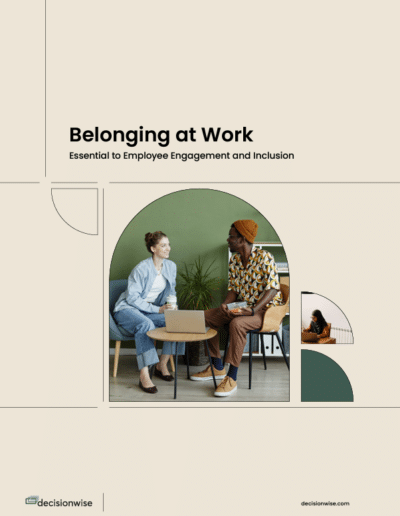
By Matthew Wride, Christian Nielson and David Long
Introduction
At DecisionWise, we have collected over 50 million employee survey responses to understand the extent to which employees are engaged in their work. Our research has consistently revealed one key element as the most important driver of employee engagement – a simple six-word statement:
“I feel like I belong here.”
When employees indicate they “agree” or “strongly agree” with this sentiment on engagement surveys, we nearly always find accompanying high levels of employee engagement throughout the organization. Belonging at work is about feeling accepted, comfortable, and connected to the organization’s culture; it means feeling excited and positive about one’s place within the organization – both currently and in the future.
In the current landscape of social media proliferation, many mistakenly assume that belonging is simply a matter of participating in an organization with social support or working among a group of friends. Our research tells us that belonging is more than social connection to one’s team or teammates. It is a sense “membership” to the organization as a whole. An employee experiences belonging when the organization gives them purpose, path, and place.
To better understand the concept of belonging, we conducted an extensive statistical review¹. We found that a sense of belonging at work is a crucial driver of employee engagement.¹
Belonging in the Workplace
Belonging is vital in the workplace, and why it matters can’t be overstated. People spend over half of their productive hours at work and build many key relationships with coworkers. The employment relationship is unique because relationships are established for the employee by the organization, including the frequency, duration, and quality of interactions, which are governed by the organization’s culture. Despite having less control, employees still need to feel a sense of belonging in their work environment. Belonging is key to successful employment, and it does not disappear whether an employee is physically or virtually present.
Belonging as a Fundamental Human Need
We have long understood that interpersonal connection is a fundamental human need. In his acclaimed ‘hierarchy,’ Abraham Maslow stated that our social needs must be fulfilled before we can contemplate higher-order needs, like esteem or self-actualization. In 1995, Professors Roy Baumeister and Mark Leary advanced further on this idea, scientifically studying and recognizing what, until then, most considered a self-evident truth: people have an inherent need to belong (Baumeister & Leary, 1995, p. 497). Baumeister & Leary referred to their theory as “belonginess.”
[H]uman beings have an all-encompassing impulse to form and sustain at least a minimum amount of positive, long-term, and meaningful interpersonal relationships. … [A] great deal of human behavior, emotion, and thought is driven by this basic interpersonal motive.”²
They note that belonginess has two essential aspects. Firstly, individuals require regular interactions from a known group of people they trust, and secondly, they need to be part of a steady, lasting culture of belonging. (Baumeister & Leary, 1995, p. 511).³ This latter point is of particular interest as we seek to comprehend belonging at work. Put differently, in practice, what does a culture of concern look like inside a modern workforce?
Belonging and Employee Engagement
Our analysis of employee experience survey responses revealed the importance of belonging in the workplace for employee engagement. Employee engagement is a positive emotional response to the employee experience, which can result in increased motivation, improved key performance indicators, higher retention rates, and increased satisfaction. Our aim was to identify which elements of the employee experience had the greatest influence on developing employee engagement.
We found the strongest predictors of engagement by looking at the results of over 600 organizational-level regression analyses, each predicting the top influencers of engagement for its respective organization.
In 75% of the regression tests we performed, the phrase “I feel like I belong here” was the top predictors of engagement. Moreover, in almost half of the cases, it was the most influential predictor.
These results demonstrate that belonging is perhaps the most important element in understanding and driving employee engagement.
Other Belonging Factors
To augment our understanding, we also performed a factor analysis on 40,000 responses in our database. The results showed that statements in Table 1 are positively correlated with the statement “I feel like I belong here.”
- I feel like I belong here.
- I feel that I can share my ideas and opinions without fear of negative consequences.
- My work is valued by this organization.
- I am satisfied with the opportunities for my own professional growth in this organization.
- This organization values employee input, feedback, and suggestions.
- This organization trusts employees to do their jobs.
- I feel comfortable in this organizations culture.
- This organization cares about employees.
This analysis suggests that employees who feel like they belong in the organization feel that their work is valued, they are comfortable in the organization’s culture, they can share their ideas and opinions freely, they have opportunities for professional growth, and the organization trusts and cares about them. This information can be used by leaders to identify areas where the organization excels in fostering a sense of belonging and areas where improvement is needed.
Create an Organizational Culture of Belonging
To begin the process of creating a sense of belonging at the organizational level, we suggest four basic action items.
1. Cultivate a Culture of Caring from the Top Down
2. Empower Employees Through Belonging, Path, and Purpose
3. Value Employee Voice
4. Build a Connection through “Riding for the Brand”
1. Cultivating a Culture of Caring from the Top Down
Our research shows that creating a sense of belonging cannot be achieved by solely focusing on individual teams. Having a great manager and a team with positive social interactions does not guarantee an engaged workforce. A sense of belonging is achieved by having a high-quality team experience combined with a feeling of “membership” in the larger organization, a culture of caring that starts from the top. This is what we mean by giving employees a “place” to belong.
2. Empowering Employees Through Belonging, Path, and Purpose
To foster a sense of belonging, employees need both a path and a purpose. They need to see how they fit within the organization and have a clear path for growth and development. Employees need to feel that the organization provides the right environment for them to thrive and become the best versions of themselves. The path must also show how they can make an impact and contribute to the organization’s success and that of its customers. This helps employees overcome one of their core personal challenges: Are they moving forward or regressing backwards?
3. Valuing Employee Voice
Employee voice is crucial in creating a culture of belonging at work. Employees must feel heard and accepted to experience belonging. Employee voice allows employees to be their authentic selves and feel that their ideas and contributions matter. Belonging cannot exist when employees feel like nobody cares about what they have to say. Belonging requires two-way communication and dialogue.
4. Building a Connection through “Riding for the Brand”
Managers play a crucial role in building belonging at both the team and organizational levels.⁴ We use the metaphor of “riding for the brand” from the frontier west. When a cowboy signed on with a cattle operation, they were taught to “ride for the brand.” This meant that the cowboys saw themselves as a reflection of the entire operation and were the brand in the eyes of the townspeople. Similarly, managers are the brand in the eyes of the employees. However, managers should not be high-priced corporate cheerleaders. They should value the relationship employees have with the larger organization and communicate with the team with the intention of building connections with other teams and organizational leaders. Managers should foster a shared sense of purpose with other teams and departments and help create a feeling that everyone is part of the same larger organizational team.
Diversity, Equity, and Inclusion
A focus on belonging also has the added benefit of addressing many diversity, equity, and inclusion (DEI) challenges. Belonging requires deep inclusion, which goes beyond quotas and superficial initiatives. A focus on belonging means that diverse voices are given due consideration, improving DEI outcomes. A focus on belonging yields universal benefits, including improved diversity, equity, and inclusion.
Conclusion
When leaders intentionally promote a culture of belonging by giving employees a purpose, path, and place, they are using the employee experience as a powerful tool for business success. By meeting the needs of each employee, they attract, retain, and engage top talent.




